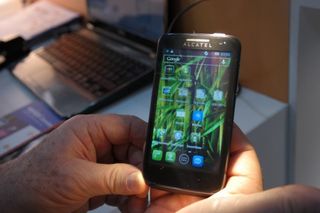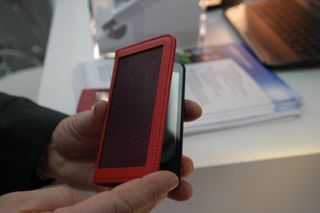Alcatel OneTouch Smartphone Solar Charges, Downloads Data via Light
At CES, we were blown away by Sunpartner's Wysips Connect sensor, which allows a smartphone to charge via solar power and receive data from light, using LiFi technology.Apparently, Alcatel OneTouch is equally impressed with this groundbreaking technology, because at Mobile World Congress, the company unveiled a phone with the sensor inside. We had a chance to go hands on with a prototype device at Sunpartner's Mobile World Congress booth and see it grabbing power and data from an LED light.
The sample we used was a version of Alcatel OneTouch's M'Pop phone, which contained the Wysips Connect strip as a transparent layer in its screen. Unfortunately, apart from its model name, Sunpartner was unable to provide any specs for the device on display. However, if it is a typical M'Pop, then it has a 4-inch, 800 x 480 display, a 1-GHz single core processor, a 5-MP camera and a VGA front-facer, and dual sim card support. Those aren't impressive components, but if Alcatel OneTouch comes out with the device we saw, it could be useful for developing markets where power is scarce. We reached out to Alcatel OneTouch to ask if it plans on selling the product we saw and will update this article when we learn more.

MORE: 12 Worst Android Annoyances and How to Fix Them
In our brief hands-on, we were able to navigate around the around the phone's Android desktop and place it under two different LED lamps. With a custom,LiFi-enabled app loaded, the first lamp caused the phone to show a particular animation while the second lamp made it launch another. SunPartner's Francis Robcis explained that the phone can receive data from any LiFi-enabled LED light at up to 20 Kbps, though that transfer rate should increase in future iterations of the the Wysips Connect sensor. The LiFi technology works by causing the lights to pulsate in a high-speed, but imperceptible pattern which the sensor reads as data. LiFi technology can be used for indoor location tracking as well as data transfer. Just imagine putting your phone under a light at the store and getting a coupon for the soup on the shelf in front of you.
While few places use LiFi today, the sun is everywhere so we expect users will get more mileage out of the phone's solar charging feature. Robcis said that, when the phone is asleep, it can charge at a rate of 20 percent per hour in direct sunlight. With its screen on, that rate drops to about 10 percent. Under indoor light, Robics said that the phone is unlikely to increase its charge, but it should be able to maintain its level when in standby.
Robcis also showed us two prototype folio-style cases for the phone, which allow it to gather more light and charge faster. One case had a simple window on it, which allowed us to see the phone's screen when it was closed. The window was equipped with Wysips charging technology so it allowed the phone to charge, even with the cover on and provided double the charging when folded open to allow both the window and the phone screen access to sunlight. A second case had a thick, photovoltaic sensor in place of the window. We could not see through this thicker sensor, but Robcis told us it is 30 percent efficient as compared to 8 percent for the phone's screen or the see-through window.

Whether Alcatel decides to sell the phone we saw or use this technology in future handsets, this week's demonstration is a step forward for Wysips technology. We look forward to seeing where this technology goes.
Stay in the know with Laptop Mag
Get our in-depth reviews, helpful tips, great deals, and the biggest news stories delivered to your inbox.

